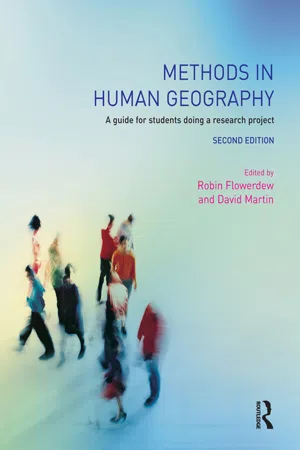Social Sciences
Primary Research
Primary research involves the collection of original data through methods such as surveys, interviews, and observations. It is conducted by the researcher to address specific research questions or objectives. In the social sciences, primary research provides firsthand information and insights, allowing researchers to gather data directly from individuals or groups to analyze and draw conclusions.
Written by Perlego with AI-assistance
Related key terms
1 of 5
7 Key excerpts on "Primary Research"
- eBook - PDF
Writing Spaces 2
Readings on Writing
- Charles Lowe, Pavel Zemliansky(Authors)
- 2011(Publication Date)
- Parlor Press, LLC(Publisher)
153 Introduction to Primary Research: Observations, Surveys, and Interviews Dana Lynn Driscoll Primary Research: Definitions and Overview How research is defined varies widely from field to field, and as you progress through your college career, your coursework will teach you much more about what it means to be a researcher within your field. * For example, engineers, who focus on applying scientific knowledge to develop designs, processes, and objects, conduct research using simulations, mathematical models, and a variety of tests to see how well their designs work. Sociologists conduct research using surveys, interviews, observations, and statistical analysis to better understand people, societies, and cultures. Graphic designers conduct research through locating images for reference for their artwork and engaging in background research on clients and companies to best serve their needs. Historians conduct research by examining archival materials— newspapers, journals, letters, and other surviving texts—and through conducting oral history interviews. Research is not limited to what has already been written or found at the library, also known as secondary * This work is licensed under the Creative Commons Attribution-Noncommercial-ShareAlike 3.0 United States License and is subject to the Writing Spaces’ Terms of Use. To view a copy of this license, visit http:// creativecommons.org/licenses/by-nc-sa/3.0/us/ or send a letter to Creative Commons, 171 Second Street, Suite 300, San Francisco, California, 94105, USA. To view the Writing Spaces’ Terms of Use, visit http://writingspaces. org/terms-of-use. Dana Lynn Driscoll 154 research. Rather, individuals conducting research are producing the ar-ticles and reports found in a library database or in a book. Primary Research, the focus of this essay, is research that is collected firsthand rather than found in a book, database, or journal. - eBook - PDF
- Ekwal Imam(Author)
- 2021(Publication Date)
- NEW INDIA PUBLISHING AGENCY (NIPA)(Publisher)
Chapter – 2 Collection of Data Studying this chapter will enable us: To understand the meaning and purpose of data collection To distinguish between primary and secondary sources To know the mode of data collection 2.1. INTRODUCTION The purpose of collecting data is to collect evidence for reaching a sound and clear solution to a problem. In this chapter we will study the sources of data, mode of data collection and its techniques. Sources and Types of Data Statistical data can be obtained from two sources: (i) Primary and (ii) Secondary The enumerator (person who collects the data) may collect the data by conducting an enquiry or an investigation or experiment. Such data are called Primary Data, as they are based on first hand information. Thus, the data are considered to be primary when it is collected and processed for the first time. If the data have been collected and processed (scrutinized and tabulated) by some other agency and used by another agency, such type of data are called Secondary Data. Generally, Secondary Data is collected 11 Basics of Research Methodology 12 from already published data. Secondary data can be obtained either from published sources or from any other sources like a web site, scientific journals, books, reports, etc. 2.2. PRIMARY DATA COLLECTION METHODS In primary data collection, we collect the data ourselves using methods such as experiments, observations, interviews and questionnaires. The key point here is that the data we collect is unique to us and our research and, until we publish, no one else has access to it. There are many methods of collecting primary data and the main methods include: 2.2.1. Research, Experiment and Observation Research is a systematic investigation in order to establish facts and reach new conclusions. It is used to discover or verify information presented. A research may be based on laboratory experiment or observation of nature or natural objects in the field. - eBook - PDF
Research Methods For Business
A Skill Building Approach
- Uma Sekaran, Roger Bougie(Authors)
- 2016(Publication Date)
- Wiley(Publisher)
111 INTRODUCTION Having discussed a number of basic issues in research design in the previous chapter, we will now turn to primary data collection methods – or ways in which data collected from original sources for the specific purpose of this study can be gathered. Data collection methods are an integral part of research design, as shown in the shaded portion of Figure 7.1. The aim of this chapter is to introduce a commonly used method of primary data collection: interviewing. Different types of interviews are discussed and ways in which to structure and carry out interviews are explained. The chapter starts with an introduction to primary data collection methods. PRIMARY DATA COLLECTION METHODS Since business is largely a social phenomenon, much of the information needed to make decisions in the work setting has to come from people – for instance from employees, consumers, managers, investors, and/or suppli- ers. For this reason, interviews, observation, and questionnaires are very popular in business research; these methods allow the researcher to collect a wide variety of different sorts of data from human respondents. We discuss these methods in, respectively, Chapter 7, Chapter 8, and Chapter 9. After we have discussed these non‐ experimental approaches to the collection of primary data, we discuss experimental designs in Chapter 10. In this way, our discussion on primary data collection methods is organized around four principal methods of primary data collection. INTERVIEWS C H A P T E R 7 LEARNING OBJECTIVES After completing Chapter 7, you should be able to: 1. Differentiate primary from secondary data collection methods. 2. Plan, design, and carry out a personal interview. 3. Plan, design, and carry out a group interview. 4. Discuss the advantages and disadvantages of interviewing. - Ronald C. Martella, J. Ron Nelson, Robert L. Morgan, Nancy E. Marchand-Martella(Authors)
- 2013(Publication Date)
- The Guilford Press(Publisher)
These sources can be placed into one of two categories—primary and secondary (Marshall & Rossman, 2011). Much of the information collected through pri- mary and secondary sources is gained through interviews and document analyses. Primary Sources. The first category, primary sources, includes oral testimony of individuals who were present at the time, documents, records, and relics. The obvious advantage of primary sources is that the data are from sources that were present when the events took place. These sources are considered to be primary, because they were present or developed dur- ing the time period under investigation. These sources are usually considered to be the most reliable type of information. The reason these primary sources are considered more reliable than other sources is that as we go farther from the original source of information, the infor- mation tends to change. For example, a typical exercise in introduction to psychology classes is to begin a story at one side of the room. A professor may tell one student, “Research is an important endeavor because we can learn about ourselves.” The first student whispers to a sec- ond student the same statement as accurately as possible. This continues until we reach the last student in the class. Finally, when the profes- sor asks the last student what she was told, she looks puzzled and hesitant, but says, “Research is a potent river that makes us yearn about our shelves.” As we go farther from the original student and what he stated, we get more and more changes in both content and meaning. People who misunderstand the original mean- ing may try to fill in the gaps so the message makes sense. Thus, to know what the original statement was, we should get as close to the first student, or the original source, as possible.- eBook - PDF
Sociology
The Essentials
- Margaret L. Andersen; Howard F. Taylor, Margaret Andersen, Howard Taylor(Authors)
- 2016(Publication Date)
- Cengage Learning EMEA(Publisher)
During this stage of the research process, the researcher interviews people, observes behaviors, or collects facts that throw light on the research question. When sociologists gather origi-nal material, the product is known as primary data . Exam-ples include the answers to questionnaires or notes made while observing group behavior. Sociologists often rely on secondary data , namely data that have already been gath-ered and organized by some other party. This can include national opinion polls, census data, national crime statis-tics, or data from an earlier study made available by the original researcher. Secondary data may also come from official sources, such as university records, city or county records, national health statistics, or historical records. Viewing Society in Global Perspective: Human Development Index Data: United Nations. 2012. International Human Development Indicators 2013 http://www.undp.org/content/undp /en/home/librarypage/corporate /undp_in_action_2010.html The Human Development Index is a series of indicators developed by the United Nations and used to show the differing levels of well-being in nations around the world. The index is calculated using a number of indicators, including life expectancy, educational attainment, and standard of living. (Are these reasonable indicators of well-being? What else might you use?) map 3.1 Medium Low No data Very high High HDI: Human Development Index (HDI) Value (2011) Copyright 2017 Cengage Learning. All Rights Reserved. May not be copied, scanned, or duplicated, in whole or in part. Due to electronic rights, some third party content may be suppressed from the eBook and/or eChapter(s). Editorial review has deemed that any suppressed content does not materially affect the overall learning experience. Cengage Learning reserves the right to remove additional content at any time if subsequent rights restrictions require it. - eBook - ePub
- Baden Eunson(Author)
- 2016(Publication Date)
- Wiley(Publisher)
Once we have completed our review of the secondary data, gaps or weaknesses in the published record may have become apparent. Here is where we need to create our own primary data.Primary data
Sources of primary data may include experiments, observations and organisational records. Two major sources of primary data are the survey methods of interviews and questionnaires. Interviews are preferable to questionnaires in some circumstances, because as the researcher you have the flexibility to vary the nature of your enquiry according to the person you are interviewing. On the other hand, questionnaires can be cheaper and the data extracted from them can be more easily quantified. Questionnaires and interviews both have advantages and disadvantages that can affect the reliability and success of data collection in different circumstances.The survey methods of interviews and questionnaires are two major sources of primary data. Face-to-face interviews give researchers the opportunity both to build rapport and to observe the nonverbal behaviour of respondents.Although interviews can be varied to suit the occasion, it is important to ensure that you maintain a consistent structure and sequence of questions from interview to interview. In interviewing a number of people for a job, for example, it is essential, for the sake of both fairness and effectiveness, that similar questions be asked of all interviewees; otherwise it becomes impossible to make a legitimate choice between the applicants. Similar considerations apply when conducting survey interviews in order to gather social data. Indeed, in some circumstances, depending on the nature of the questions asked and the manner of recording the responses, the line between conducting an interview and administering a questionnaire may blur.Surveys, of course, do not necessarily produce reliable results. There is no guarantee that the interviewees will tell the truth. They may say one thing but do another. They may have contradictory beliefs and opinions. They may be trying to create a good impression or seek to give the response they think the questioner wants. They may give any response they think will persuade the questioner to go away quickly. They may even work to undermine the survey with false responses. Ensuring anonymity can help, but even this is no guarantee of totally reliable responses. These factors may impose limitations on the value of the data you gather, but if you are realistic about such limitations you may still make good use of the data. - eBook - ePub
Methods in Human Geography
A guide for students doing a research project
- Robin Flowerdew, David M. Martin, Robin Flowerdew, David M. Martin(Authors)
- 2013(Publication Date)
- Routledge(Publisher)
Section B Collecting primary data It is tempting to see primary data collection as the major component of your project, and in many cases it will certainly take up a considerable proportion of the time. However, it must be set in a context which ensures that relevant questions are asked and that the information gained is relevant to the original research questions. Primary data collection may take various forms, and the chapters in this section address questionnaire design and sampling, interviewing techniques, focus groups, ‘participatory’ research methods and participant observation. Again it is necessary to stress that the word ‘data’ here is not intended to imply that the information being collected has to be numerical. It is common for research projects to be timed such that students find it necessary to undertake their primary data collection over the long summer vacation. This has the advantage that there is a reasonably long period of time available for the work, but means that students are likely to be conducting a significant part of the work without any direct contact with their supervisor. (You should find out before the start of the vacation whether your supervisor is willing to be contacted and provide dissertation advice by e-mail.) It is therefore important to plan the primary data collection exercise very carefully in advance, including such tasks as the establishment of necessary contacts with key individuals and the piloting of questionnaires. There is little point turning up to interview some of your key respondents just after they have gone on their summer holidays, or in printing 200 questionnaires only to discover that most people misinterpret one of the central questions. A common failing is to see the primary data collection as the starting point for a research project, and to conduct it without adequate background reading or planning
Index pages curate the most relevant extracts from our library of academic textbooks. They’ve been created using an in-house natural language model (NLM), each adding context and meaning to key research topics.






